
Even though I have been to plenty of superb performances this year there are a few good ‘uns that I’ve missed. Work, the Olympics and a family holiday have scuppered John Wilson at the Proms, the Proms weekend at the Bristol Beacon, a trip to the Berlin Music Fest for Ives IV and more. However, there are certain Copland works that I consider to be filed under “Cancel all engagements”. Music for a Great City is one of those.
I only found out that the Outcry Ensemble were playing this 10 days before the concert. I had already purchased tickets for a Bristol Flyers basketball game but in a game of top trumps, Copland usually comes out on top!
So, I found myself at Smith Square last Sunday to see an absolute belter of a concert. As often is the case I tried my luck and asked in advance if I could attend the rehearsal. Many of the bigger orchestras these days reserve this privilege for generous sponsors only. Outcry Ensemble and their conductor / founder / artistic director James Henshaw were by contrast most accommodating.
What I hadn’t banked on was my train being cancelled. This meant that the later 12 o’clock train was likely to rammed with all my fellow passengers from the 11 o’clock. This volume of additional people and more coaches being added made for a tardy departure – a further 17-minute delay. I was nervous. It was going to be touch and go whether I would get across London to Smith Square in time. The worry, confusion and terror were all very fitting considering the music what was ear worming through my head and I was eagerly anticipating hearing in all its glory.
Music for a Great City is based on the soundtrack to the feature film Something Wild. Copland’s cues to this psychological drama include the claustrophobic Subway Jam and the frenetic Escape through the City. Indeed, for me it turned out to be Music for a (mad dash in the rain across) a great city!
As I pegged it up the steps outside of Smith Square I could hear the majestic opening chords of Skyline. But I came around the wrong side and the doors were locked. There was a moment of Basil Fawty panic but thankfully, it wasn’t far around to the other side and I got inside and sat down a bit soggy and pretty sweaty. The rush was worth it though – I’d hardly missed a beat.
Music for a Great City is truly rare Copland. I frequently wonder why this almighty work gets so few outings especially in the US? According to the Boosey and Hawkes performance calendar it’s only been performed three times in its entirety, anywhere in the world since 2010. I am probably one of the few people that can chalk up seeing it performed twice. I was there in 2018 at Snape Maltings to see the last ever performance of the dearly departed Olly Knussen and the BBC Symphony Orchestra.
I could tell right from the moment I sat down that this was going to be a special day. It was obvious that both the conductor Henshaw and the percussionists were in their element. But the whole of the Outcry Ensemble were right on top of it from that monumental first explosion of sound. Copland wrote a lot of very difficult music. Musicians always remark on this. With the more obscure Copland I expect some dodgy moments. I didn’t hear any in the rehearsal or the performance.
Now there is a good reason for this and James Henshaw was keen to share his views with the audience both at the pre-concert talk and during the performance. The Outcry Ensemble are made up of young performers, mostly under the age of 30 all trying to make their mark and get noticed. Henshaw told the audience that only two orchestras in London have salaried, full-time players (BBC SO and the Royal Opera House). All the rest including the London Symphony Orchestra are made up of freelancers. This creates a hugely competitive music scene with everyone having to constantly up their game to get the gig. He remarked on the fact that in London, players can pick up new music in an instant and added that this should be celebrated and rewarded. In his view, nowhere else in the world do you get players who are so skilled and able to adapt to the difficult, comprehend the new and perform it flawlessly.
I couldn’t have been more impressed. The programme demonstrated massive ambition – four big works that were a bold and forthright clarion call entreating the audience to shed their ear muffs and get out of their comfort zone and listen to a more contemporary music. One of the bullets in the mission statement in the programme claims that the Outcry Ensemble is different because to them:
New music is normal music
It’s a rallying cry that I wholeheartedly salute.
Henshaw said that the concert was quite an undertaking – and how it hadn’t dawned on him at first just how daunting this programme was going to be. In fact, I personally can’t think of a performance I have ever been to where there was so few compromises. Every piece had all the bells and whistles – and with the Copland piece that’s not just me speaking literally!
Let’s look at that a bit more:
- An ensemble so huge that I am certain that there were more players and singers than audience members. Over 150 members in total. The stalls started at Row J as so much space was taken up by this humungous group.
- Benjamin Britten’s Young Person’s Guide to the Orchestra was done with a narrator – I think that is pretty rare these days (unless performed by a Children’s Orchestra).
- The Copland piece with its enormous percussion and brass forces. The five strong percussion team Craig Apps, George English, Lewis Blee, Gareth Ceredig and Ryan Hepburn were playing the snare drum, tenor drum, conga drum, a pair of timbales, bass drum, woodblock, high and low temple blocks, cleves, slapstick, triangle, high and low cow bells, sandpaper, ratchet, suspended and crash cymbals, gong, glockenspiel, xylophone and vibraphone. There was additional gusto provided by timpanist Tom Lee.
- I had imagined that considering what elase was on the programme, Stephen Dodgson‘s Te Deum might be a short 10-minute filler. But not a bit of it, this was a thirty six minute work with chorus and three soloists. An important and imposing piece that like the others could have been the headline act.
- And then William Walton’s Belshazzar’s Feast. Not satisfield with the full orchestra, chorus and soloist Nicholas Mogg the final movement brought in an additional 14 brass players playing offstage at either side of the upper circle. I rarely hear anything that compares to the sheer brilliant noise of a Copland climax, but at times in the rehearsal I actually worried for the sake of my ears!
Honestly, it was immense!
At the interval (following Music for a Great City) I was jauntily skipping down the stairs and I heard a fellow audience member say to his friend “That was quite good”. It was possibly one of the biggest understatements I have ever heard. I wanted to shout
That was (expletive) brilliant!
The whole concert was ace but I want to talk a bit more about Music for a Great City.
The concert series that Outcry Ensemble are performing takes its name from this work. It was commissioned by the London Symphony Orchestra for their 60th anniversary in 1964 but of course it’s not about London, but a picture postcard of New York City. Copland reworked the Something Wild score into this amazing work. Now I’ve talked about the similarities between West Side Story and Something Wild before and the possibility that Copland was influenced by Leonard Bernstein to produce an even harder edged soundtrack of New York.
I recently introduced the piece to Prof Neal Farwell of Bristol University and said that I could not get my head around why it doesn’t get played that often. He posited that the bleak storyline (rape victim who gets saved from suicide and then gets imprisoned by her saviour before succumbing to Stockholm Syndrome) might put programmers off. I guess there is something in that!
However, I countered by saying that some of the plot of West Side Story is hardly a great advert for NYC either – plenty of knife crime, gang violence, attempted gang rape and multiple homicides! Perhaps it’s more that people don’t know it and that means going out on a limb for programmers. West Side Story is iconic and far more likely to put bums on seats.
I have often said that Copland paints amazing pictures. Listening to this piece again LIVE I suddenly had the thought that Copland should actually have won awards for his landscape and cityscape painting! I can’t think of anyone who produces such vivid images with music. No words or explanation required – you know the inner thoughts of the composer and what he is trying to convey. I know I am biased, but I truly believe that the colourful imagery that Copland creates makes him nothing short of a Great Master.
I want to introduce you to a few bits that I think sound like anything else you will hear in a concert venue. Beside all the crash bang and wallop of the ensemble playing there are such deft uses of orchestration, stripped right back but bringing together unusual combinations of instruments that create the most fascinating sound world. Here’s a few examples:
Skyline
Not sure what percussion instrument is making the amazing sound at 2.24 of Skyline? Woodblocks perhaps? But it completely mimics the sound of a jackhammer being used in roadworks.
The combination of xylophone, cow bells (I think) and strings at 3.50 signals a brilliant change of pace to eery unease. This is from The Park at Night cue in the film and starts as Mary Ann says goodbye to her friends and enters Central Park.
The mood becomes even more creepy at 5.21. I think this is a combination of celesta and oboe. In the film it is used as accompaniment to Mary Ann’s bad dream and features in the Incarceration and Nightmares cue.
The tension increases at 6.01 with absolutely brilliant full throttle double bass playing. The recorded version doesn’t do this justice but it was magnificent in the concert.
Night Thoughts
Wonderful strings and oboe here convey a dreadful resignation with the short motif sounding like Mary Ann’s staggered breathing as she bathes in the bath and scrubs herself following her awful rape.
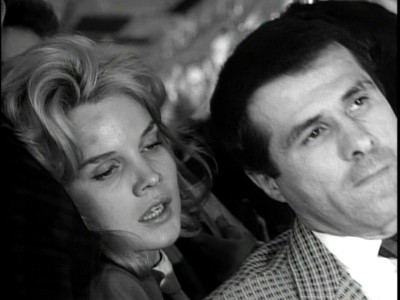
Carroll Baker as Mary Ann in Something Wild. Claustophobic Subway Jam.
Subway Jam
One thing to note about Music for a Great City compared to Something Wild – I much prefer the version of Subway Jam in the film cue. For some reason Copland didn’t use the fast drum roll on the snare drum in the orchestral suite. Why I don’t know? This denotes the moment the train goes through a metro station without stopping. Now, I’ve since started to doubt myself, but it sounded like in the concert, the Something Wild original was played with the snare drum roll intact. I might be wrong, but it did sound closer to the original for me and all the better for it. Certainly, it doesn’t seem to be present in the LSO recorded version. Listen to 1.17 and 1.44 from the Something Wild soundtrack and watch on the Criterion Collection (scroll right to the fith image).
I can’t think of another case where muted trombones are used so expansively in a piece of music. It brilliantly brings to music Mary Ann’s uncomfortable, breath sapping, cheek by jowl, metro ride. In the film she gets to her stop but feints on the platform.
Towards the bridge
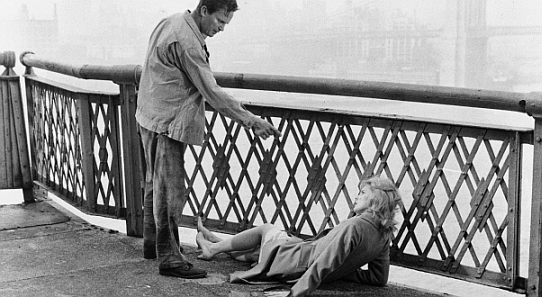
Ralph Meeker and Carroll Baker in Something Wild. Mike prevents Mary Ann from jumping off the bridge and scolds her for thinking about it.
I love a good stinger chord and this movement opens with a corker – 10 seconds long.
Some brilliant trumpet work here too. Listen from 1.20 – Incredible muted trumpets and am I right that there’s some flutter tonguing there too? It does feel like a really weird take on Ives’s The Unanswered Question. The response from the strings is truly disturbing – certainly not an answer anyone would want. In the film the question is answered by Mike, the mechanic who stops Mary Ann from jumping from the bridge and then takes her back to his basement flat.
I could go on. Surely, it’s time this Copland work is recognised for what it is. One of the best movie soundtracks of all time.
A few thank yous are necessary. The original idea to program Music for a Great City came from violinist and co-leader Laura Rickard. I can’t thank her enough for putting this forward.
I must also applaud James Henshaw for the dynamism and enthusiasm he showed all day. I was there for most of the proceedings and he never stopped. Three hours of rehearsals, a quick chat with me, a meagre 10 minute break to change clothes, followed by the pre-concert talk and the 2.5 hour concert followed by meet and greets at the post-concert fundraiser. A wonderful work ethic and tremendous commitment to the cause. It was completely full on for him all day and he left nothing out there.
On my part I did leave something behind! The only downside to my day was the hasty retreat I had to make as soon as the concert ended. The lethargy of the Circle Line was the complete opposite of what came before and I missed my train home to Bristol by 8 minutes. It was therefore a bit of a late one for me and that took some of the shine off my visit. Also, in my haste, despite retrieving my umbrella (which I am always forgetting) I fled without my lime green cashmere scarf. If someone found it please let me know!
The standard of the concetr and the many transport mishaps add to the reasons why I want to bring the music I love closer to home. My hope is that the Copland 125 Festival will add to the vibrant artistic scene and provide more Music for a Great City – not London or New York, but Bristol, my City!
Afterthoughts
When I listen in depth to contemporaneous pieces by Copland’s peers I often hear a fleeting similarity to a Copland work. With Britten I think his Dawn from Four Sea Interludes bears more than a passing resemblance to an obscure cue from Copland’s score to the movie Our Town called Town at Night. Listen to the latter here.
Coming back on the train, I couldn’t stop thinking about the recurring theme in Walton’s Thus in Babylon the Mighty City section of Belshazzar’s Feast. I knew it put me in mind of a Copland motif. It later occurred to me what it was – The Prelude of The Second Hurricane opera. Not identical by any means but certainly not a million miles different either. Have a listen and see what I mean.

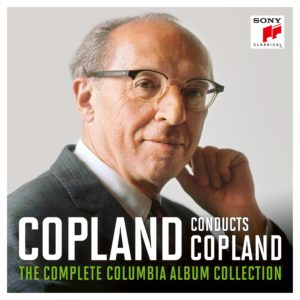
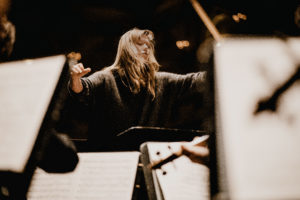
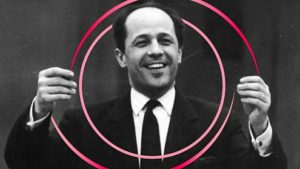





Leave a Comment